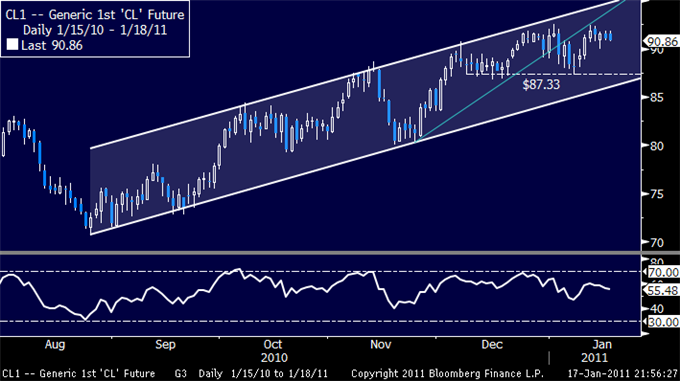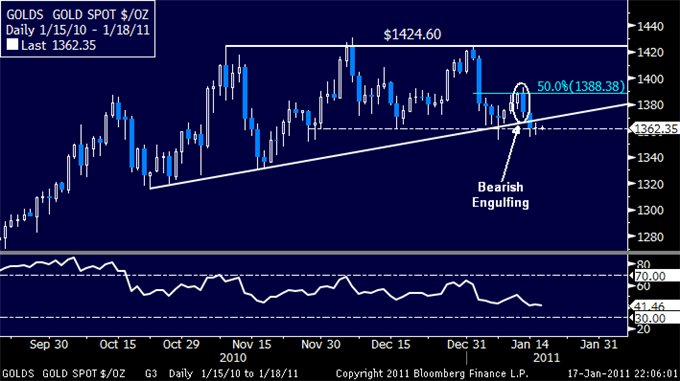U.S. stocks rose for a seventh straight week Friday, the longest rally since May 2007, buoyed by optimism about corporate earnings and European efforts to control the region's debt crisis. JPMorgan (JPM: 44.91 +0.46 +1.03%) jumped 2.9% as the lender posted record quarterly profit. Financial shares in the Standard & Poor's 500 Index climbed 3.2% after Wells Fargo (WFC: 32.75 +0.86 +2.70%) raised its rating for large banks on prospects for higher dividends. Higher oil prices boosted energy shares, which climbed the most among S&P 500 groups. Micron (MU: 9.71 +0.08 +0.83%), Nvidia (NVDA: 23.59 +0.20 +0.86%) and Novellus Systems (NVLS: 36.85 +4.04 +12.31%) all surged at least 12% amid optimism about semiconductor demand.
Today's Market Moving Stories
China Impacts
Overnight China's stocks fell 3%, driving the benchmark index to the lowest level in three months, as the central bank ordered banks to set aside more reserves and rising property prices signaled tightening measures may be expanded. Industrial and Commercial Bank of China Ltd. and China Construction Bank Corp. led declines for banks after the government boosted reserve requirements for the fourth time in two months. China Vanke Co. and Poly Real Estate Group Co., the nation's largest property developers, slid more than 3 percent. Qingdao Haier Co., a home appliances maker, dropped the most in two months on concern higher interest rates will damp spending.
The focus on China this week will be intense with the Hu/Obama meetings due to take place. Some articles out over the weekend in the WSJ on this..
U.S. Presses China for Deals
The US pressing China to buy tens of billions of dollars in US aircraft, auto parts, agricultural goods and beef to build goodwill when the two countries' leaders meet Wednesday. Chinese President Hu Jintao, in written answers to questions from The Wall Street Journal and another U.S. newspaper, emphasized the need for cooperation with the U.S. ahead of his U.S. visit this week, but called the present U.S. dollar-dominated currency system a "product of the past."
More Euro Uncertainty
The euro is weaker almost across the board ahead of Monday/Tuesday meetings of Ecofin and the Eurogroup. Nothing ground breaking has occurred, but several small developments have conspired against the currency. Over the weekend the UK's Telegraph reported that Irish banks are facing liquidity problems, while the ECB's Orphanides commented this morning that the market may have over-reacted to last week's ECB press conference (widely viewed as hawkish).
The US is closed today – so expect a slow start to the week – with most focus on any comments / sound bites coming out from ECOFIN meeting – Merkel comments over the weekend (see below) seems to confirm that Germany will not back an enlarged EFSF right now – but come up with a long lasting solution in March (Fiscal Union ?)
Merkel said on Saturday any measure to stabilize the euro should come within a complete strategic package, dampening hopes for a quick decision on moves to tackle the euro zone debt crisis. Germany faces mounting pressure from the European Commission and its euro zone partners to strengthen a rescue fund for troubled member states, the European Financial Stability Facility (EFSF)."If the discussion is about a further package of measures, it is above all important that we develop a complete strategy that must absolutely include closer economic coordination… (Sounds like a fiscal union, if Germany should.
More concern about emergency lending to Irish banks
Not ECB lending mind you – this is lending by the Irish central bank to Irish banks. Questions now being asked in the media whether Irish Central bank is indulging in a bit of QE "on the sly". All over the press – Saturday's FT, Sunday's Irish Independent, today's Telegraph, zerohedge, Irish chat rooms etc. Concern over the lack of transparency – the lending is listed under the "other assets" column on the central bank's balance sheet. No further details given. Basically, although ECB lending to Irish banks fell slightly in December, the lending via the Irish central bank increased by more than enough to compensate. In other words, things are still getting worse for the banks. Evans-P in the Telegraph headlines with: "Irish lenders besiege central bank for emergency loans"…
Telegraph says Irish lenders besiege central bank for emergency loans. And why is all this official cash needed? Because foreign depositors are pulling their cash out, even if the Irish public have not started to withdraw and bury theirs. Investors from outside the Euozone have pulled out 108 bn since late 2008. A lot of this would likely be destined for UK.
UK House Prices Up
The average price asked for by home-sellers in the U.K. edged up for the first time in three months, amid a shortage of supply that could offer some support to house prices in the coming months, data from an estate agency showed Monday. Property website Rightmove's January survey showed asking prices up 0.3% on the previous month, following sharp declines in November and December, and hovering 0.4% above prices in the comparative month a year before. Signs of cautious optimism from home-sellers contrast with the economic fundamentals facing the housing market. Prices are set to struggle under the weight of public-sector job cuts, pay rises that fail to match inflation, banks' continued reluctance to lend freely and the prospect of higher interest rates sooner or later.
Ernst & Young LLP's Item Club said say the Bank of England must "hold its nerve" and not raise its key interest rate until the recovery shows signs of overcoming the impact of the government's budget squeeze. "With inflation likely to reach 4 percent this spring, the Monetary Policy Committee will come under intense pressure," the research group said in a report in London today. It should "keep base rates where they are until it is clear that the economy is taking the fiscal adjustment in its stride." The central bank maintained emergency stimulus last week as it weighed the threats of spending cuts against the risk that higher oil prices and sales tax rate will keep inflation above the government's 3 percent limit. Citigroup Inc., Societe Generale and BNP Paribas SA said this month the bank may increase the benchmark rate faster than previously anticipated.
Company / Equity News
- Travis Perkins Plc: Down 2.4% as the U.K.'s biggest building merchant was downgraded to "sell" from a "buy" at Societe Generale
- UK & Irish banks are under pressure in Europe today with brief the press late evening Barclays shedding 1.3% as Prime Minister David Cameron said his government has had detailed talks with banks over pay and is pressing for lower bonuses, higher taxes for banks and more lending to small businesses. "We've been having very detailed discussions with Barclays and the other major clearing banks to try to get settlement of this issue," Cameron said in an interview with BBC Radio 4's "Today" show.
- Lloyds: Slipped 2.4%on speculation it is to be broken up. On the ISEQ Allied Irish Banks has tumbled 5.3% bringing its decline in the past 12 months to 81 percent after Copenhagen-based Danske Bank said it was not considering buying Allied's Northern Ireland business, following a Sunday Times report.
- Schroders: Down 2.9% after UBS downgraded the stock to "neutral" versus "buy."
- BP (BP: 49.25 +1.71 +3.60%) deal with Russia has not gone down well in Washington, so expect some further deterioration of BP's hopes there (no longer #1 supplier to US Military and any further Govt related contracts look wishful thinking).
- Airbus SAS will today announce 2010 orders that will beat those of Boeing Co. in terms of value, daily Les Echos reported, without citing anyone. Gross orders at Airbus last year were close to 600 planes, with net orders between 540 and 550, the newspaper said. The company will announce a new order for the A320 NEO today, Les Echos added.
- Today is the deadline for final bids for EBS, with Irish Life & Permanent and Cardinal Asset Management reported to be the final two bidders. It is reported over the weekend that Cardinal has drawn up plans to bid for Irish Permanent if successful in acquiring EBS. The consortium is believed to have met with the NTMA, the Dept of Finance and the Central Bank. Separately, Irish Permanent is expected to raise its variable rates by 0.5% next month to 4.7%, in a move that is expected to be followed by the sector.

